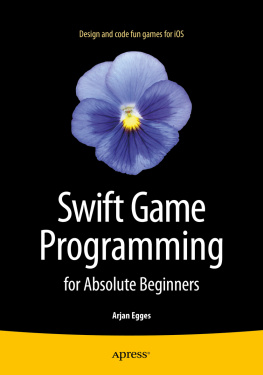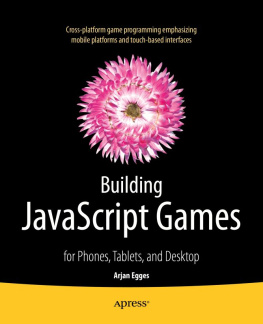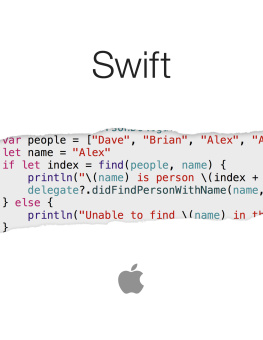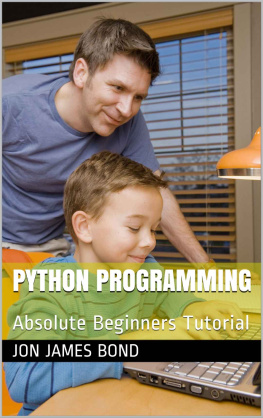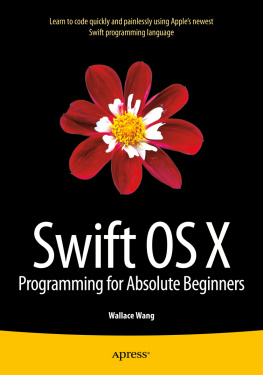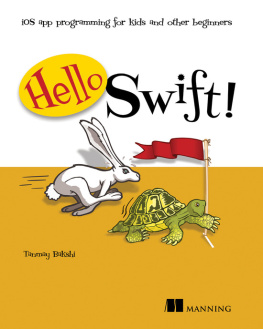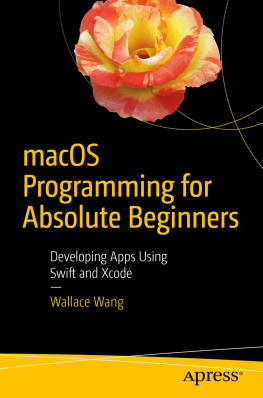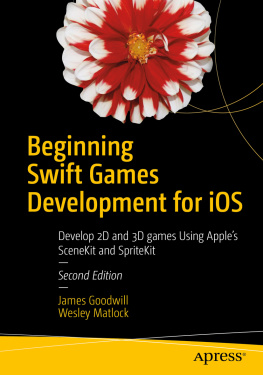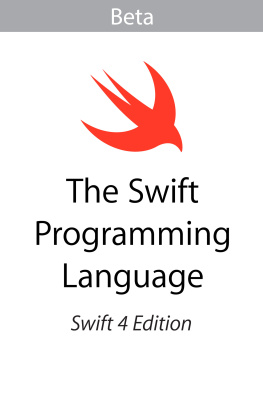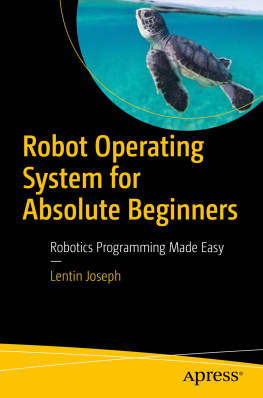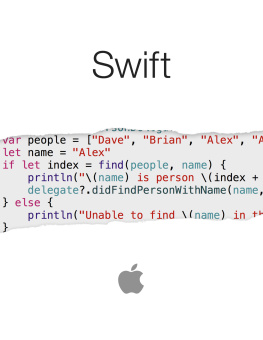This chapter provides an introduction to the Swift programming language. Swift is one of the more recent developments in the evolution of programming languages. In order to understand Swift, you need to first understand how computers (including iOS devices such as iPads or iPhones) work, and how the languages used to program them have evolved. After talking about computers and programs (including apps) in general, Ill give an introduction to Swift and how you can use some of its basic features to create your first program.
Computers and Programs
This section briefly covers computers and programming in general. After that, youll move on to programming your first application using Swift.
Processors and Memory
Generally speaking, a computer consists of one or more processors and forms of memory . This is true for all modern computers, including game consoles, smartphones, and tablets. I define memory as something that you can read information from and/or write things to . Memory comes in different varieties, mainly differing in the speed of data transfer and data access. For example, a computer may have memory in the shape of (relatively slow) hard disk memory, much faster RAM (Random Access Memory), a USB flash drive thats connected to the machine, or an open network connection to a server that has memory itself. The main processor in the computer is called the central processing unit (CPU) . The most common other processor on a computer is a graphics processing unit (GPU) .
The main task of the processor is to execute instructions . The effect of executing these instructions is that the memory is changed. Especially with my very broad definition of memory, every instruction a processor executes changes the memory in some way. You probably dont want the computer to execute only one instruction. Generally, you have a very long list of instructions to be executedMove this part of the memory over there, clear this part of the memory, draw this image on the screen, check if the player is pressing a key on the gamepad, and make some coffee while youre at itand (as you probably expect) this list of instructions that is executed by the computer is called a program .
Programs
In summary, a program is a long list of instructions to manipulate the computers memory. However, the program itself is also stored in memory. Before the instructions in the program are executed, theyre stored on a hard disk, a DVD, or a USB thumb drive; or on any other storage medium. When they need to be executed, the program is moved to the RAM memory of the machine.
The instructions that, combined together, form the program need to be expressed in some way. You could use gestures, or make weird noises. Unfortunately, the computer doesnt understand this very well (although with the motion tracking devices of today, perhaps it will understand in a couple of years). The computer also cant grasp instructions typed in plain English (yet), which is why you need programming languages such as Swift. In practice, the instructions are coded as text, but you need to follow a very strict way of writing them down, according to a set of rules that defines a programming language. Many programming languages exist, because when somebody thinks of a slightly better way of expressing a certain type of instruction, their approach often becomes a new programming language. Its difficult to say how many programming languages exist because that depends on whether you count all the versions and dialects of a language; but suffice to say that there are thousands.
Fortunately, its not necessary to learn all these different languages because they have many similarities. In the early days, the main goal of programming languages was to use the new possibilities of computers. However, more recent languages focus on bringing some order to the chaos that writing programs can cause.
Programming Languages
In the early days, programming computer games was a very difficult task that required great skill. A game console like the popular Atari 2600 had only 128 bytes of RAM, which is really small compared to todays computers (4GB of RAM is nearly 33,000 times as much as 128 bytes). It also used cartridges with at most 4,096 bytes of ROM (Read-Only Memory) that had to contain both the program and the game data. This limited the possibilities considerably, and the machines were also extremely slow.
Programming such games was done in Assembly, a very basic programming language that defined a set of instructions that a processor could execute. Each processor could have a different set of instructions, leading to different Assembly languages. As a result, every time a new processor came around, all existing programs had to be completely rewritten for that processor. Therefore, a need arose for processor-independent programming languages. This resulted in languages such as Fortran (FORmula TRANslating System) and BASIC (Beginners All-purpose Symbolic Instruction Code). BASIC was very popular in the 1970s because it came with early personal computers such as the Apple II in 1978, the IBM-PC in 1979, and their descendants. Unfortunately this language was never standardized, so every computer brand used its own dialect of BASIC.
As programs became more complex, it became clear that a better way of organizing all these instructions was necessary. So, procedural languages were created; they grouped instructions into procedures (also called functions , or methods ). A well-known example of a procedural language is C, which was defined by Bell Labs in the late 1970s. C is still used quite a lot, although its slowly but surely making way for more modern languages, especially in the game industry.
Over the years, games became much larger programs, and teams rather than individuals created them. It was important that the game code be readable, reusable, and easy to debug. Object-oriented programming languages address this need, by letting programmers group methods into something called a class . The memory that groups of methods are related to is called an object . A class can describe something like the ghosts in a game of Pac-Man. Then each individual ghost corresponds to an object of the class. This way of thinking about programming is powerful when applied to games. Another powerful aspect of object-oriented programming is inheritance, which allows developers to extend existing code and add functionality to it. Youll read more about inheritance and how you use it in games in .
In the early eighties, two programmers named Brad Cox and Tom Love created a language called Objective-C, which was an extension of C in which object-oriented programming was possible. In 1988, the Objective-C language was licensed to NeXT, the company founded in 1985 by Steve Jobs after he was forced out of Apple. NeXT developed a lot of tools around the Objective-C language, such as a tool for building interfaces, as well as a development environment called Project Builder, the predecessor of what we now call Xcode. When Jobs returned to Apple in the nineties, the tools developed at NeXT became the foundation for Mac OS X.

